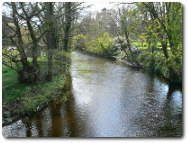Synopsis of Hurrahing in Harvest
Inspiration
 Hurrahing in Harvest is a sonnet written in 1877, whilst Hopkins was studying for the priesthood at St.Beuno's, North Wales. In a note he tells us how it was written: ‘The Hurrahing sonnet was the outcome of half an hour of extreme enthusiasm as I walked home alone one day from fishing in the Elwy', the Elwy being the river that flows through the Vale of Clwyd in which St.Beuno's is situated.
Hurrahing in Harvest is a sonnet written in 1877, whilst Hopkins was studying for the priesthood at St.Beuno's, North Wales. In a note he tells us how it was written: ‘The Hurrahing sonnet was the outcome of half an hour of extreme enthusiasm as I walked home alone one day from fishing in the Elwy', the Elwy being the river that flows through the Vale of Clwyd in which St.Beuno's is situated.
The poem is reminiscent of John Keats' Ode to Autumn. As with Keats, Hopkins gains an almost mystical experience, though, because Hopkins was a Christian, he expresses it much more in religious terms in trying to see God directly in the scene.
More on Keats: Keats, in a letter, describes a similar moment of intense pleasure in looking on the stubble fields whilst on holiday near Winchester. Hopkins' and Keats' poems must be set side by side as two of the best celebratory poems in the English language concerning autumn.
Textual notes
As in a slightly earlier sonnet, The Windhover, Hopkins' language and poetic rhythms are very complex and syncopated. The images, likewise, try to fix the scene exactly: to fix its inscape in the octave and, in the sestet, to work out its particular impression on the onlooker, its instress. The result is a complicated but very rewarding poem.
Investigating Hurrahing in Harvest
- Try to recall some autumn scenes you have seen.
- Can you remember the weather and the atmosphere?
A sonnet is a poem with a special structure. It has fourteen lines, which are organised in a particular manner, usually characterised by the pattern of rhyming, which changes as the ideas in the poem evolve.
Used for the seeking of direct spiritual encounter with God, usually through a life of self-denial and contemplation.
Name originally given to disciples of Jesus by outsiders and gradually adopted by the Early Church.
Rhythm is the musical effect of the repetition of stresses or beats, and the speed or tempo at which these may be read.
1. Imitation, copy, likeness, statue, picture in literature, art or imagination.
2. A figure of speech in which a person or object or happening is described in terms of some other person, object or action (i.e. as a metaphor or simile)
A term used by Gerard Manley Hopkins to denote the uniqueness of a person or piece of Nature, such as a landscape, a cloud formation or waves on the sea. It is the artist's trained perception to grasp this uniqueness of form and being.
The 8-line stanza of a Petrarchan sonnet, always occupying the first eight lines. It sometimes has a division halfway, creating two quatrains. It poses a problem or describes some single object or incident.
The 6-line stanza of a Petrarchan sonnet, occupying the last six lines, sometimes divided into tercets or couplets. It often resolves the problem posed in the octave or comments significantly on it.
A term invented by Gerard Manley Hopkins to denote the way an inscape impinges itself on the mind of the perceiver, and the emotional colouring produced.
 Hurrahing in Harvest is a sonnet written in 1877, whilst Hopkins was studying for the priesthood at St.Beuno's, North Wales. In a note he tells us how it was written: ‘The Hurrahing sonnet was the outcome of half an hour of extreme enthusiasm as I walked home alone one day from fishing in the Elwy', the Elwy being the river that flows through the Vale of Clwyd in which St.Beuno's is situated.
Hurrahing in Harvest is a sonnet written in 1877, whilst Hopkins was studying for the priesthood at St.Beuno's, North Wales. In a note he tells us how it was written: ‘The Hurrahing sonnet was the outcome of half an hour of extreme enthusiasm as I walked home alone one day from fishing in the Elwy', the Elwy being the river that flows through the Vale of Clwyd in which St.Beuno's is situated.